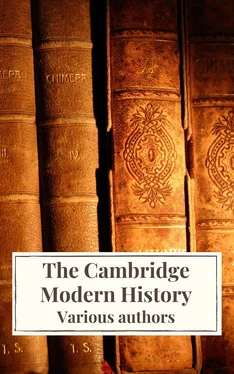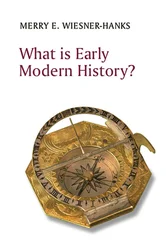R. Nisbet Bain - The Cambridge Modern History
Здесь есть возможность читать онлайн «R. Nisbet Bain - The Cambridge Modern History» — ознакомительный отрывок электронной книги совершенно бесплатно, а после прочтения отрывка купить полную версию. В некоторых случаях можно слушать аудио, скачать через торрент в формате fb2 и присутствует краткое содержание. Жанр: unrecognised, на английском языке. Описание произведения, (предисловие) а так же отзывы посетителей доступны на портале библиотеки ЛибКат.
- Название:The Cambridge Modern History
- Автор:
- Жанр:
- Год:неизвестен
- ISBN:нет данных
- Рейтинг книги:4 / 5. Голосов: 1
-
Избранное:Добавить в избранное
- Отзывы:
-
Ваша оценка:
- 80
- 1
- 2
- 3
- 4
- 5
The Cambridge Modern History: краткое содержание, описание и аннотация
Предлагаем к чтению аннотацию, описание, краткое содержание или предисловие (зависит от того, что написал сам автор книги «The Cambridge Modern History»). Если вы не нашли необходимую информацию о книге — напишите в комментариях, мы постараемся отыскать её.
The first series was planned by Lord Acton and edited by him with Stanley Leathes, Adolphus Ward and George Prothero.
The Cambridge Modern History Collection features all five original volumes:
Volume I: The Renaissance
Volume II: The Reformation, the End of the Middle Ages
Volume III The Wars of Religion
Volume IV: The 30 Years' War
Volume V: The Age of Louis XIV
The Cambridge Modern History — читать онлайн ознакомительный отрывок
Ниже представлен текст книги, разбитый по страницам. Система сохранения места последней прочитанной страницы, позволяет с удобством читать онлайн бесплатно книгу «The Cambridge Modern History», без необходимости каждый раз заново искать на чём Вы остановились. Поставьте закладку, и сможете в любой момент перейти на страницу, на которой закончили чтение.
Интервал:
Закладка:
We have no right to inflict a complete patristic bibliography on our readers. One more Greek father only shall be mentioned, namely, Eusebius of Caesarea. His Praeparatio Evangelica has been mentioned more than once in the body of this chapter. George of Trebizond’s Latin version of it-faulty as it was-was printed again and again before 1500. The Greek text appeared at Paris in 1544 from the press of Robert Estienne. The same indefatigable worker brought out in the same year the History of Eusebius in Greek for the first time, along with the later Greek ecclesiastical historians. In Latin the history had long been current, and the sixteenth century had seen at least two fresh Latin versions, made by Wolfgang Musculus and by Christopherson. It was reserved for Valesius (Valois), in 1659, to produce the first really great illustrative edition of this priceless record of Christian origins.
The Latin Fathers demand a briefer treatment than those of the Greek Church. A good deal has been said already as to the reappearance of those authors who had been forgotten, and as to the labours of scholars upon the text of some who had always been studied. We may, therefore, in this place confine ourselves to a select few of the earlier Latin writers. The Apology of Tertullian was printed in 1483; but the first edition of any considerable part of his works was supervised by Beatus Rhenanus in 1521. Gagnaeus of Paris added some eleven tracts to those previously known, in 1545; and Sigismund Gelenius improved the text. By 1625 the whole of the writings we possess had appeared in print, and the editions were numerous. Those of Rigault, of which the first appeared in 1633, did most for the text of this earliest of the great Christian Latinists. Rigault had access to all the principal manuscripts, whether preserved in France, as those of Pithou and Dupuy, with the famous “Agobardian” Codex, in Germany, as that of Fulda, or in Italy, as that of Fulvio Orsini.
Cyprian, in a gravely interpolated text, was read throughout the medieval period, and five editions of his works appeared between 1471 and 1500. He was one of the host of writers who profited by the scholarship of Erasmus; the first Basel edition came out in 1520, and was often reprinted. Latino Latini undertook to edit the works, but was prevented from completing them; the results of his labours, taken up by others, saw the light in 1563 at Rome. The same decade witnessed the appearance of Morel’s Paris edition (1564), and of that of J. de Pamele (Antwerp, 1568); the former is said to have improved the text, the latter to have corrupted it by the use of interpolated manuscripts. An “epoch-making” edition was that of Nicholas Rigault in 1648.
The Latin Apologists alone remain to be discussed. Lactantius, first printed in 1465, was one of those writers who appealed most strongly to the humanists; and the number of reprints of his works, belonging to the fifteenth and sixteenth centuries, is correspondingly great. The first critical edition worth mentioning is probably that of Basel (1563) with the commentary of Xystus Betuleius.
Arnobius and Minucius Felix go together. The only two manuscripts of their writings which we possess have handed down the Octavius of the latter as if it were part of the Disputationes of the former; and two editions appeared before the mistake was detected. The first was that of Faustus Sabaeus of Brescia (Rome, 1543), librarian of the Vatican, to whom our oldest manuscript (now at Paris) belonged. The second was by Sigismund Gelenius, three years later, at Basel.
Of the great post-Nicene Fathers, Eastern or Western, we have decided not to speak in this place. It has already been said that they had attracted attention from the first moment of revival; and, though much notable work was done in collecting and publishing their writings during the sixteenth century, a review of that work would swell the present chapter to an undue size.
We prefer to notice the rise of those great collections of the minor Christian writings which are generically known as the Bibliothecae Patrum. It was the chief merit of these that they brought together, and put into the hands of a large circle, a number of brief tracts of the most diverse ages, which ran the risk either of passing unnoticed or dropping out of existence altogether. That the texts of the works thus published were uniformly good we neither expect nor find; but of their extreme value to the men of their time there can be no doubt. Even now they are the best available authorities for a good many writings.
The series is headed by a publication of Sichard of Basel (1528), called Antidotum contra diversas...haereses. It contains treatises by twenty authors, the earliest of whom is Justin Martyr.
The Microprestyticon of 1550, also a Basel book, numbers thirty-two writers. Aristeas, the fabulous Chronicle of “Philo,” and the Letters of Ignatius and Polycarp, are among its contents. Five years later appeared the Orthodoxographa, edited by Herold, with seventy-six headings. The collection of Grynaeus, issued with the same title in 1569, includes eighty-five. The printer of these four was Henricus Petri. Basel, then, began the work with credit. Zurich produced somewhat similar publications, between 1546 and 1572, under the auspices of Conrad Gesner and Simler. But the productions of the two Swiss cities were surpassed, if not superseded, by the issue in 1575 of the first edition of the Paris Bibliotheca Veterum Patrum. Its editor was Marguerin de la Bigne, and the collection appeared in eight sections or classes arranged according to the character of the writings in each. In the first, for example, were Epistles, in the sixth Commentaries, and so forth. A supplementary volume was issued in 1579. Something over 220 writers of all ages, from the first to the sixteenth century, are represented altogether; and the whole work is in Latin. It was dedicated to Gregory XIII. In 1589 came a second edition, in nine volumes, increased by the addition of a good many treatises, but marked also by the omission of several which had called forth the censure of the authorities. Among these were the works of Nicholas de Clemanges, whose animadversions on ecclesiastical matters had seemed to surpass the bounds of fair criticism. So dangerous, indeed, did the collection appear to some minds that the Jesuit Possevin declares that it is impossible, salva conscientia, to keep either of the first two editions of the Bibliotheca on one’s shelves, and more than one detailed censure of the book was issued. In the editions of 1610 and later, efforts were made to remedy the faults that had been noted; and in 1624 appeared the first of a series of publications in which the Greek texts of some of the authors hitherto only published in Latin were given. This first auctarium was edited by the Jesuit Fronton le Due (Ducaeus). The final and largest form of de la Bigne’s Bibliotheca was issued in 1644, in seventeen volumes. It contained writings of about two hundred additional authors.
A rival to the Paris Bibliotheca soon appeared, in the shape of the Magna Bibliotheca of Cologne. The first fourteen tomes, with preface by Alard Wyel, were published in 1618: a fifteenth by Andreas Schott in 1622. Their appearance provoked the publication of an auctarium to the Paris collection by Gilles Morel at Paris in 1639. A noticeable point about the Cologne Bibliotheca is that its contents are digested in chronological order, each volume comprising the writers of a century. Similar arrangements were adopted in most of the subsequent Bibliothecae. Cologne did not continue the rivalry; and the last great work of the seventeenth century in this department was again the product of a French press. It was the Maxima Bibliotheca, issued at Lyons in 1677, in twenty-seven parts. The next century witnessed the appearance of a still more comprehensive corpus of patristic literature in the shape of Gallandi’s Bibliotheca (Venice, 1766); but the publication of Migne’s enormous Patrology-never likely to be surpassed in extent-in the middle of the nineteenth century has largely superseded the earlier collections which we have been reviewing. Let us attempt, in a few closing paragraphs, to sum up the results of an investigation which has covered, however incompletely, a wide range both in space and in time. We have seen reason to place the first symptoms of a revival of Christian learning as far back as the thirteenth century, and to connect the beginnings of the movement with England. In the fourteenth century the scene of activity is shifted to Italy, where the impulse given to classical studies reacts upon theology. Not until late in the fifteenth century are the effects of this awakening visible to much purpose in France or in Germany, in the Low Countries or in Switzerland; but throughout the succeeding centuries these countries continue to produce indefatigable workers and noble monuments of learning, while Italy, and more evidently Spain, gradually lose the predominance they had once held. The rapidity with which the light spread in Germany has been the subject of comment already: France’s achievements are not less noteworthy. Lefevre d’Etaples, Michel Vatable the Hebraist, Gentien Hervet the translator, the Estiennes, who cover the whole field of Greek and Latin literature, de la Bigne, Rigault, Dachery, Fronton le Due, Combefis-all strenuous workers in the patristic and medieval departments-these form an imposing list, and one that might be largely increased without difficulty. Nor does the succession of scholars cease with them: it continues throughout the seventeenth century, and culminates in the noble erudition of the Congregation of St Maur.
Читать дальшеИнтервал:
Закладка:
Похожие книги на «The Cambridge Modern History»
Представляем Вашему вниманию похожие книги на «The Cambridge Modern History» списком для выбора. Мы отобрали схожую по названию и смыслу литературу в надежде предоставить читателям больше вариантов отыскать новые, интересные, ещё непрочитанные произведения.
Обсуждение, отзывы о книге «The Cambridge Modern History» и просто собственные мнения читателей. Оставьте ваши комментарии, напишите, что Вы думаете о произведении, его смысле или главных героях. Укажите что конкретно понравилось, а что нет, и почему Вы так считаете.












